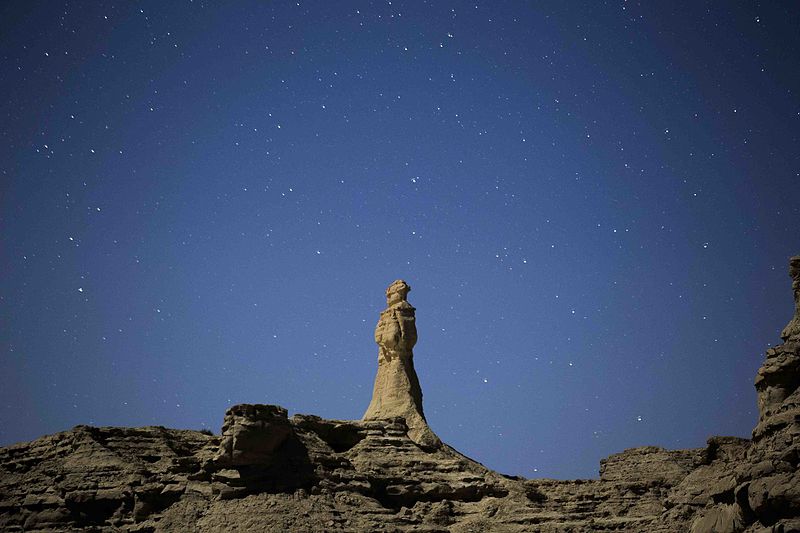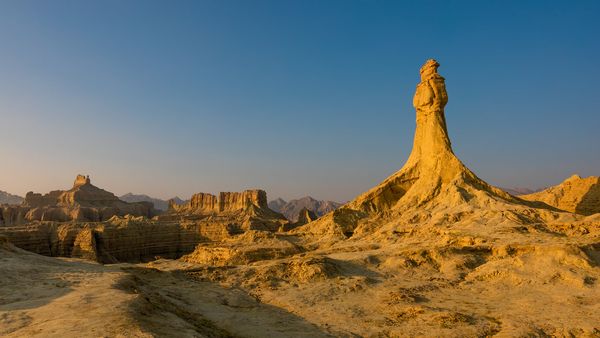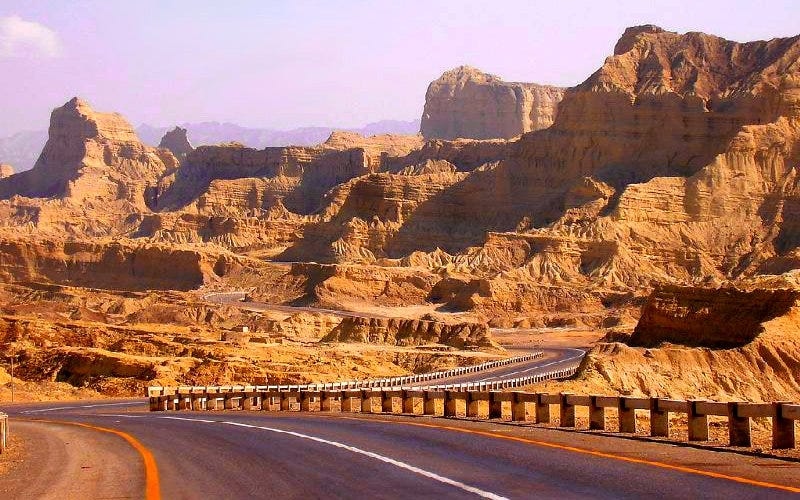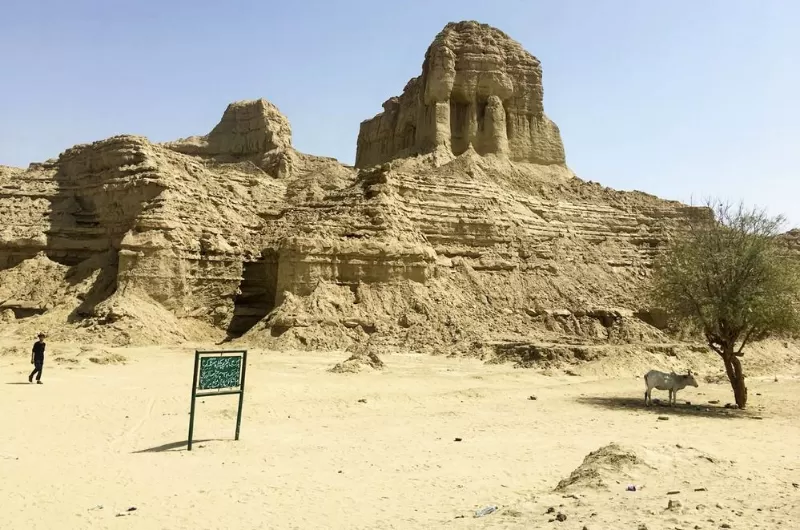
About the Princess of Hope
A Natural Marvel Amidst the Barren Beauty of Balochistan
In the heart of Pakistan’s vast and rugged Balochistan province stands a hauntingly beautiful sculpture — not carved by human hands, but shaped by the forces of nature over centuries. Known as the Princess of Hope, this striking rock formation resembles a regal woman gazing towards the horizon, standing tall amidst the surreal landscape of the Hingol National Park. A silent sentinel of time, the Princess of Hope is more than just a geological marvel; she is a symbol of endurance, mystery, and the natural artistry of the earth.
A Serendipitous Discovery
The name “Princess of Hope” was coined in 2002 by Hollywood actress Angelina Jolie, who visited the area as a UN Goodwill Ambassador. Captivated by the elegant, human-like form of the rock, she remarked that it looked like a hopeful princess watching over the barren lands. The name stuck — romantic, poetic, and deeply evocative.
But while the name may be recent, the formation itself is millions of years old, sculpted slowly by the forces of wind and rain erosion. Towering at over 100 feet, this limestone rock formation remains one of Pakistan’s most iconic natural landmarks and a prime attraction within Hingol National Park.
Geographical Setting: The Majesty of Hingol National Park
The Princess of Hope is located in Hingol National Park, Pakistan’s largest national park, spanning over 6,100 square kilometers. This landscape is characterized by an otherworldly mixture of rocky mountains, deep gorges, coastal beaches, and desert plains. Hingol lies about 190 kilometers from Karachi, along the Makran Coastal Highway, making it accessible for tourists and nature enthusiasts.
The park is home to a rich array of biodiversity — including the rare Sindh ibex, Balochistan bear, and various species of birds, reptiles, and marine life. Despite its arid environment, the region thrives with life, showcasing nature’s adaptability and resilience.
The Geological Wonder
What makes the Princess of Hope particularly unique is the uncanny resemblance to a human figure — a woman clad in a robe, seemingly in motion or deep contemplation. This resemblance is not the result of any man-made effort but a natural phenomenon known as “hoodoos” or “rock spires.”
Hoodoos are formed when harder rocks sit atop softer rocks. Over millennia, the softer rock erodes due to wind and water, while the harder capstone protects the column below. Eventually, striking shapes emerge — sometimes mimicking human or animal forms. The Princess of Hope is one such formation, created purely through natural sculpting.
The sedimentary rock, largely composed of limestone and clay, has been shaped by Balochistan’s harsh climate, where temperature extremes and occasional rains combine with desert winds to slowly chisel away the terrain.
Symbolism and Cultural Interpretation
While the Princess of Hope is not tied to any ancient legend or folklore, the name and figure have become symbolic of strength, grace, and optimism in an otherwise bleak terrain. The anthropomorphic form is often interpreted as a representation of hope standing tall amidst adversity, a poignant metaphor for the province of Balochistan itself — a region rich in culture and history, yet often overshadowed by hardship.
Many locals and tourists see the Princess as a silent guardian of the region, a beacon of resilience, echoing the untold stories of the past and the enduring spirit of its people.
Neighboring Attractions: The Sphinx of Balochistan
Close to the Princess of Hope stands another fascinating formation — the Balochistan Sphinx, also known as the Lion of Balochistan. Just like its Egyptian counterpart, this rock structure resembles a sphinx with a lion’s body and a human face, drawing equal attention for its mysterious appearance.
Together, the Princess of Hope and the Sphinx form a natural sculpture gallery, reminding travelers of ancient civilizations and lost eras, even though these formations are not man-made. Their proximity to each other adds to the allure of the region and encourages deeper exploration of the natural world’s architectural genius.
Tourism and Preservation
In recent years, the Princess of Hope has gained attention as an emerging eco-tourism destination. Nature lovers, photographers, geologists, and road-trippers frequently visit the site, especially those traveling along the Makran Coastal Highway, which itself is a scenic journey along the Arabian Sea.
The Government of Pakistan and local authorities have made efforts to promote the site, although infrastructure in the area still needs improvement. Basic amenities, such as rest stops, guided tours, or informational signage, are limited. Nonetheless, the raw beauty of the site remains its biggest appeal.
With growing tourism, concerns about preservation and environmental impact are also rising. The rock formations are delicate and could be damaged by human interference, vandalism, or climate-related erosion. Sustainable tourism practices are essential to ensure that these wonders remain intact for future generations.
A Photographer’s Paradise
One of the reasons for the increasing popularity of the Princess of Hope is its photogenic nature. The contrast between the rugged rock and the deep blue sky, especially during sunrise or sunset, creates a dramatic visual scene. The solitary figure standing against the vast desert background provides a perfect subject for landscape photography and documentary storytelling.
The area is particularly popular among adventure enthusiasts, hikers, and overland travelers, who seek off-the-beaten-path destinations. With more drone and social media photography, the Princess of Hope has earned a place in travel journals and documentaries highlighting Pakistan’s hidden treasures.
Access and Travel Tips
If you’re planning to visit the Princess of Hope, here are a few tips to enhance your journey:
- Route: Drive via the Makran Coastal Highway from Karachi towards Gwadar. The formation lies near Hingol National Park, roughly 4–5 hours from Karachi.
- Best Time to Visit: October to March, when temperatures are cooler and more manageable.
- Essentials: Carry water, food, fuel, sunscreen, and a hat. Mobile signals may be limited, and there are few facilities nearby.
- Travel Mode: 4x4 vehicles are recommended, especially for off-road exploration.
- Guides: While tours are available through local travel groups, independent travelers should plan their route and safety measures in advance.
Conclusion
The Princess of Hope is more than a geological curiosity — it is a symbol of enduring beauty carved by the silent, patient hand of nature. As Pakistan opens its doors to local and international tourists, destinations like this remind us of the untamed wonders that lie beyond popular travel circuits. Amid the raw wilderness of Hingol, the Princess stands — hopeful, timeless, and awe-inspiring — beckoning travelers to pause, reflect, and marvel at the artistry of the natural world.
Address: Princess of Hope, N-10, Pakistan







